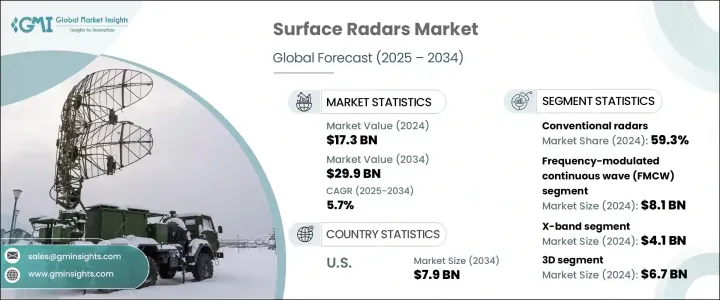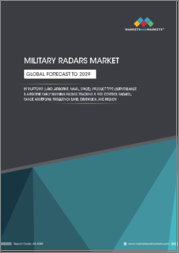
|
시장보고서
상품코드
1740780
표면 레이더 시장 기회, 성장 촉진 요인, 산업 동향 분석, 예측(2025-2034년)Surface Radars Market Opportunity, Growth Drivers, Industry Trend Analysis, and Forecast 2025 - 2034 |
||||||
표면 레이더 세계 시장은 2024년에는 173억 달러로 평가되었으며 CAGR 5.7%로, 2034년에는 299억 달러에 이를 것으로 추정됩니다.
이 성장의 주요 요인은 레이더 시스템의 급속한 기술 진보와 세계 방어 인프라의 현대화에 대한 관심 증가입니다. 높은 레이더 시스템에 대한 수요가 급증하고 있습니다. 방위 전략이 다 영역 작전으로 발전함에 따라 최첨단 레이더 기술을 보다 대규모의 지휘 통제 네트워크에 통합하는 것이 분명히 중시되고 있습니다.

이전에는 표면 레이더 업계에 영향을 미친 중대한 외부 요인 중 하나는 트럼프 정권에 의한 관세의 도입이었습니다. 부품 비용의 상승은 전체 생산 비용을 증가시키고 조달 주기를 연장시켰습니다. 그 결과, 제조업체들은 현지 또는 대체 공급업체를 중심으로 소싱 전략을 재검토해야 했습니다.
| 시장 범위 | |
|---|---|
| 시작 연도 | 2024년 |
| 예측 연도 | 2025-2034년 |
| 시작 금액 | 173억 달러 |
| 예측 금액 | 299억 달러 |
| CAGR | 5.7% |
이 시장은 레이더 유형, 파형, 차원, 거리에 따라 구분됩니다. 레이더 유형 중에서 기존 레이더 부문이 2024년 59.3%로 가장 큰 시장 점유율을 차지했으며, 예측 기간 동안 계속 지배할 것으로 예상됩니다. 이 시스템은 성숙도가 높고 다양한 용도에서 일관된 성능을 발휘하고 민간용과 군용 모두에서 신뢰성과 적응성을 제공하기 때문에 여전히 높은 수요가 있습니다.
파형별로 분석하면 주파수 변조 연속파(FMCW) 부문은 2024년에 81억 달러의 평가액에 도달했습니다. 이 레이더는 공간, 중량, 전력의 제한이 중요한 임무에서 점점 선호되고 있습니다. 고성능 작전에 이상적이며 강화된 신호 명료도는 스텔스성과 정밀도를 모두 지원합니다.
레이더의 차원에서 보면 3D 레이더 분야는 2024년에 67억 달러로 평가되었습니다. 3D 레이더가 제공하는 종합적인 추적 능력은 복잡한 지형과 혼잡한 작전 지역에서 매우 중요합니다.
거리를 기준으로 2024년에는 중거리 레이더 카테고리가 44.6%로 가장 큰 점유율을 획득했습니다. 신속한 배포 및 재배치를 위해 설계된 이 제품들은 장거리 시스템의 물류 복잡성 없이 유연한 모니터링 솔루션이 필요한 시나리오에서 널리 사용됩니다.
지역적으로는 미국이 북미 표면 레이더 시장의 아성을 유지하고 있으며, 2034년까지 79억 달러 시장 규모를 달성할 것으로 예측되고 있습니다. 네트워크의 통합이 중시되어 모바일, 적응성, 네트워크 대응 레이더 기술의 성장을 지지하고 있습니다.
경쟁 측면에서 시장은 소수의 대기업에 의해 거의 독점되고 있으며, 이들 기업은 총 시장의 70%에서 75%의 점유율을 차지하고 있습니다. 시스템 내에서의 전략적 제휴에 주력하여 제품의 충실을 도모하고 있습니다. 신기술에 대한 투자나 공동 사업의 형성에 의해 주요 기업은 세계의 안보 상황에서 수요의 변화에 대응할 수 있는 체제를 정돈하고 있습니다.
목차
제1장 조사 방법과 범위
제2장 주요 요약
제3장 업계 인사이트
- 생태계 분석
- 트럼프 정권의 관세 분석
- 무역에 미치는 영향
- 무역량의 혼란
- 보복 조치
- 업계에 미치는 영향
- 공급측의 영향(주요 구성요소)
- 주요 원재료의 가격 변동
- 공급망 재구성
- 생산 비용에 미치는 영향
- 수요측의 영향(판매가격)
- 최종 시장에의 가격 전달
- 시장 점유율 동향
- 소비자의 반응 패턴
- 공급측의 영향(주요 구성요소)
- 영향을 받는 주요 기업
- 전략적인 업계 대응
- 공급망 재구성
- 가격 설정 및 제품 전략
- 정책관여
- 전망과 향후 검토 사항
- 무역에 미치는 영향
- 업계에 미치는 영향요인
- 성장 촉진요인
- 세계의 지정학적 긴장의 고조와 방위 근대화의 대처
- 해상 감시 수요 증가
- 네트워크 중심의 C4 ISR 시스템에 표면 레이더 통합
- 디지털 빔포밍과 반도체 재료의 기술적 진보
- 자율형 및 무인 수상 플랫폼에 대한 주목의 고조
- 업계의 잠재적 위험 및 과제
- 높은 개발 및 인증 비용
- 레이더 기술 이전에 대한 수출 규제와 지정학적 제약
- 성장 촉진요인
- 성장 가능성 분석
- 규제 상황
- 기술의 상황
- 장래 시장 동향
- 갭 분석
- Porter's Five Forces 분석
- PESTEL 분석
제4장 경쟁 구도
- 소개
- 기업의 시장 점유율 분석
- 주요 시장 기업의 경쟁 분석
- 경쟁 포지셔닝 매트릭스
- 전략 대시보드
제5장 시장 추정 및 예측 : 유형별, 2021-2034년
- 주요 동향
- 소프트웨어 정의 레이더
- 복수 입력과 복수 출력
- 위상 배열 레이더
- 액티브 전자 스캔 어레이
- 패시브 전자주사 어레이
- 기존 레이더
- 양자 레이더
제6장 시장 추정 및 예측 : 파형별, 2021-2034년
- 주요 동향
- FMCW
- 도플러
- 기존 도플러 레이더
- 펄스 도플러 레이더
제7장 시장 추정 및 예측 : 주파수별, 2021-2034년
- 주요 동향
- HF/UHF/VHF 밴드
- L 밴드
- S 밴드
- C 밴드
- X 밴드
- KU 밴드
- KA 밴드
- 멀티 밴드
제8장 시장 추정 및 예측 : 차원별, 2021-2034년
- 주요 동향
- 2D
- 3D
- 4D
제9장 시장 추정 및 예측 : 거리별, 2021-2034년
- 주요 동향
- 단
- 중
- 길이
제10장 시장 추정 및 예측 : 플랫폼별, 2021-2034년
- 주요 동향
- 중요 인프라
- 공항
- 항만
- 군사기지와 사령부
- 기타
- 차재
- 군사
- 상업
- 선상
- 군사
- 상업
- 무인 수상 차량
- 군사
- 상업
제11장 시장 추정 및 예측 : 용도별, 2021-2034년
- 주요 동향
- 감시
- 방공
- 경계 보안
- 전장 ISR
- 기타
제12장 시장 추정 및 예측 : 지역별, 2021-2034년
- 주요 동향
- 북미
- 미국
- 캐나다
- 유럽
- 독일
- 영국
- 프랑스
- 스페인
- 이탈리아
- 네덜란드
- 아시아태평양
- 중국
- 인도
- 호주
- 한국
- 일본
- 라틴아메리카
- 브라질
- 멕시코
- 아르헨티나
- 중동 및 아프리카
- 사우디아라비아
- 아랍에미리트(UAE)
- 남아프리카
제13장 기업 프로파일
- Aselsan AS
- Bae Systems
- Bharat Electronics Limited
- Elbit Systems Ltd.
- Hensoldt
- Indra
- Israel Aerospace Industries
- L3harris Technologies, Inc.
- Leonardo SPA
- Lockheed Martin Corporation
- Northrop Grumman
- Raytheon Technologies
- Saab
- Teledyne Flir
- Thales
The Global Surface Radars Market was valued at USD 17.3 billion in 2024 and is estimated to grow at a CAGR of 5.7% to reach USD 29.9 billion by 2034. This growth is primarily attributed to rapid technological advancements in radar systems and an increasing focus on modernizing defense infrastructure across the globe. The demand for more advanced, accurate, and reliable radar systems has surged, as countries invest in strengthening their surveillance capabilities and situational awareness. As defense strategies evolve toward multi-domain operations, there is a clear emphasis on integrating cutting-edge radar technologies into larger command-and-control networks.

One of the significant external factors that previously impacted the surface radars industry was the Trump administration's implementation of tariffs. These tariffs, which targeted imports including electronics and defense-related components, resulted in higher prices for essential radar parts like RF modules, signal processors, and circuit boards. The rise in component costs pushed up overall production expenses and extended procurement cycles. As a result, manufacturers were forced to revisit their sourcing strategies, turning toward local or alternative suppliers. While this shift ensured greater long-term supply chain resilience, it temporarily disrupted production timelines and impacted competitiveness.
| Market Scope | |
|---|---|
| Start Year | 2024 |
| Forecast Year | 2025-2034 |
| Start Value | $17.3 Billion |
| Forecast Value | $29.9 Billion |
| CAGR | 5.7% |
The market is segmented based on radar type, waveform, dimension, and range. Among the radar types, the conventional radar segment accounted for the largest market share at 59.3% in 2024 and is expected to continue dominating through the forecast period. These systems remain in high demand due to their maturity and consistent performance across various applications, offering reliability and adaptability for both civilian and military uses.
When analyzed by waveform, the frequency-modulated continuous wave (FMCW) segment reached a valuation of USD 8.1 billion in 2024. These radars are increasingly favored in missions where space, weight, and power limitations are critical. Their ability to emit low electromagnetic signatures makes them ideal for sensitive operations, while their enhanced signal clarity supports both stealth and precision. The growing requirement for compact radar solutions that don't compromise on performance is a key factor driving this segment's popularity.
In terms of radar dimensions, the 3D radar segment was valued at USD 6.7 billion in 2024. These systems are becoming a vital component of modern surveillance frameworks as they provide detailed target data, including elevation and range. The comprehensive tracking capabilities they offer are crucial in complex terrain and congested operational zones. Their compatibility with network-based defense protocols also enhances decision-making processes by offering deeper situational insights.
Based on operational range, the medium-range radar category captured the largest share at 44.6% in 2024. These radars are in high demand due to their balance between mobility, performance, and cost. Designed for quick deployment and redeployment, they are widely used in scenarios that require flexible monitoring solutions without the logistical complexities of long-range systems. Their effectiveness in monitoring fast-moving targets across broad but not excessively large areas adds to their appeal.
Regionally, the United States maintained a stronghold on the surface radars market in North America and is projected to attain a market size of USD 7.9 billion by 2034. Investment in defense modernization and homeland security continues to fuel demand. Domestic focus on integrating radar systems with digital command networks supports the growth of mobile, adaptable, and network-aware radar technologies. The drive to secure coastal, border, and infrastructure areas also amplifies the need for advanced surface radar systems tailored to dynamic and evolving threats.
On the competitive front, the market is largely dominated by a few major players, who collectively account for between 70% and 75% of the total market share. These companies are focusing on innovation, price differentiation, and strategic alliances within the defense ecosystem to enhance their offerings. By investing in new technologies and forming collaborative ventures, key players are positioning themselves to meet the shifting demands of the global security landscape.
Table of Contents
Chapter 1 Methodology and Scope
- 1.1 Market scope and definitions
- 1.2 Research design
- 1.2.1 Research Approach
- 1.2.2 Data collection methods
- 1.3 Base estimates and calculations
- 1.3.1 Base year calculation
- 1.3.2 Key trends for market estimation
- 1.4 Forecast model
- 1.5 Primary research and validation
- 1.5.1 Primary sources
- 1.5.2 Data mining sources
Chapter 2 Executive Summary
- 2.1 Industry 3600 synopsis
Chapter 3 Industry Insights
- 3.1 Industry ecosystem analysis
- 3.2 Trump administration tariffs analysis
- 3.2.1 Impact on trade
- 3.2.1.1 Trade volume disruptions
- 3.2.1.2 Retaliatory measures
- 3.2.2 Impact on the industry
- 3.2.2.1 Supply-side impact (key components)
- 3.2.2.1.1 Price volatility in key materials
- 3.2.2.1.2 Supply chain restructuring
- 3.2.2.1.3 Production cost implications
- 3.2.2.2 Demand-side impact (selling price)
- 3.2.2.2.1 Price transmission to end markets
- 3.2.2.2.2 Market share dynamics
- 3.2.2.2.3 Consumer response patterns
- 3.2.2.1 Supply-side impact (key components)
- 3.2.3 Key companies impacted
- 3.2.4 Strategic industry responses
- 3.2.4.1 Supply chain reconfiguration
- 3.2.4.2 Pricing and product strategies
- 3.2.4.3 Policy engagement
- 3.2.5 Outlook and future considerations
- 3.2.1 Impact on trade
- 3.3 Industry impact forces
- 3.3.1 Growth drivers
- 3.3.1.1 Increasing geopolitical tensions and defense modernization efforts worldwide
- 3.3.1.2 Rising demand for maritime surveillance
- 3.3.1.3. Integration of surface radars into network-centric C4 ISR systems
- 3.3.1.4 Technological advancements in digital beamforming and semiconductor materials
- 3.3.1.5 Growing focus on autonomous and unmanned surface platforms
- 3.3.2 Industry pitfalls and challenges
- 3.3.2.1 High development and certification costs
- 3.3.2.2 Export regulations and geopolitical restrictions on radar technology transfers
- 3.3.1 Growth drivers
- 3.4 Growth potential analysis
- 3.5 Regulatory landscape
- 3.6 Technology landscape
- 3.7 Future market trends
- 3.8 Gap analysis
- 3.9 Porter's analysis
- 3.10 PESTEL analysis
Chapter 4 Competitive Landscape, 2024
- 4.1 Introduction
- 4.2 Company market share analysis
- 4.3 Competitive analysis of major market players
- 4.4 Competitive positioning matrix
- 4.5 Strategy dashboard
Chapter 5 Market Estimates and Forecast, By Type, 2021 - 2034 ($ Mn & Units)
- 5.1 Key trends
- 5.2 Software-defined radars
- 5.2.1 Multiple-input and multiple-output
- 5.2.2 Phased array radars
- 5.2.2.1 Active electronically scanned arrays
- 5.2.2.2 Passive electronically scanned arrays
- 5.3 Conventional radars
- 5.4 Quantum radars
Chapter 6 Market Estimates and Forecast, By Waveform, 2021 - 2034 ($ Mn & Units)
- 6.1 Key trends
- 6.2 Frequency-modulated continuous wave (FMCW)
- 6.3 Doppler
- 6.3.1 Conventional doppler radars
- 6.3.2 Pulse doppler radars
Chapter 7 Market Estimates and Forecast, By Frequency, 2021 - 2034 ($ Mn & Units)
- 7.1 Key trends
- 7.2 HF/UHF/VHF-Band
- 7.3 L-Band
- 7.4 S-Band
- 7.5 C-Band
- 7.6 X-Band
- 7.7 KU-Band
- 7.8 KA-Band
- 7.9 Multi-Band
Chapter 8 Market Estimates and Forecast, By Dimension, 2021 - 2034 ($ Mn & Units)
- 8.1 Key trends
- 8.2 2D
- 8.3 3D
- 8.4 4D
Chapter 9 Market Estimates and Forecast, By Range, 2021 - 2034 ($ Mn & Units)
- 9.1 Key trends
- 9.2 Short
- 9.3 Medium
- 9.4 Long
Chapter 10 Market Estimates and Forecast, By Platform, 2021 - 2034 ($ Mn & Units)
- 10.1 Key trends
- 10.2 Critical infrastructure
- 10.2.1 Airports
- 10.2.2 Seaports
- 10.2.3 Military bases & command centres
- 10.2.4 Others
- 10.3 Vehicle-mounted
- 10.3.1 Military
- 10.3.2 Commercial
- 10.4 Shipborne
- 10.4.1 Military
- 10.4.2 Commercial
- 10.5 Unmanned surface vehicles
- 10.5.1 Military
- 10.5.2 Commercial
Chapter 11 Market Estimates and Forecast, By Application, 2021 - 2034 ($ Mn & Units)
- 11.1 Key trends
- 11.2 Surveillance
- 11.3 Air defense
- 11.4 Perimeter security
- 11.5 Battlefield ISR
- 11.6 Others
Chapter 12 Market Estimates and Forecast, By Region, 2021 - 2034 ($ Mn & Units)
- 12.1 Key trends
- 12.2 North America
- 12.2.1 U.S.
- 12.2.2 Canada
- 12.3 Europe
- 12.3.1 Germany
- 12.3.2 UK
- 12.3.3 France
- 12.3.4 Spain
- 12.3.5 Italy
- 12.3.6 Netherlands
- 12.4 Asia Pacific
- 12.4.1 China
- 12.4.2 India
- 12.4.3 Australia
- 12.4.4 South Korea
- 12.4.5 Japan
- 12.5 Latin America
- 12.5.1 Brazil
- 12.5.2 Mexico
- 12.5.3 Argentina
- 12.6 Middle East and Africa
- 12.6.1 Saudi Arabia
- 12.6.2 U.A.E.
- 12.6.3 South Africa
Chapter 13 Company Profiles
- 13.1 Aselsan A.S.
- 13.2 Bae Systems
- 13.3 Bharat Electronics Limited
- 13.4 Elbit Systems Ltd.
- 13.5 Hensoldt
- 13.6 Indra
- 13.7 Israel Aerospace Industries
- 13.8 L3harris Technologies, Inc.
- 13.9 Leonardo S.P.A.
- 13.10 Lockheed Martin Corporation
- 13.11 Northrop Grumman
- 13.12 Raytheon Technologies
- 13.13 Saab
- 13.14 Teledyne Flir
- 13.15 Thales


















